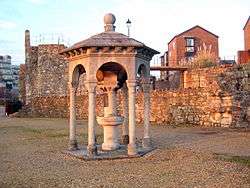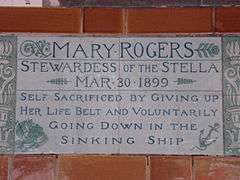SS Stella (1890)
Stella was a passenger ferry in service with the London and South Western Railway (LSWR) that was wrecked on 30 March 1899 off the Casquets during a crossing from Southampton, to Guernsey.
 SS Stella | |
| History | |
|---|---|
| Name: | Stella |
| Owner: | London and South Western Railway |
| Port of registry: | Southampton |
| Route: | Southampton - Channel Islands |
| Builder: | J & G Thompson, Clydebank |
| Cost: | £62,000 |
| Yard number: | 252 |
| Launched: | 16 September 1890 |
| Completed: | October 1890 |
| Out of service: | 30 March 1899 |
| Identification: | United Kingdom Official Number 97219 |
| Fate: | Wrecked on The Casquets, Channel Islands |
| General characteristics | |
| Tonnage: | 1,059 GRT |
| Length: | 253 ft (77.11 m) |
| Beam: | 35 ft (10.67 m) |
| Propulsion: | 2 x triple expansion steam engines |
| Speed: | 19½ knots (36 km/h) |
| Capacity: | 712 passengers |
| Crew: | 43 |
Construction
Stella was built by J & G Thompson Ltd, Clydebank as yard number 252. She was launched on 15 September 1890 by Miss Chisholm. The builders completed the ship in 1890. She was 1,059 GRT and was powered by two triple expansion steam engines which could propel her at 19½ knots (36 km/h).[1]
Stella was 253 feet (77.11 m) long, with a beam of 35 feet (10.67 m). She could carry 712 passengers and carried 754 lifejackets, 12 lifebuoys and her lifeboats could carry 148 people. Her sister ships were Frederica and Lydia.[2]
Shipwreck
Stella was built for the LSWRs Southampton - Channel Island services.[3] On Maundy Thursday, 30 March 1899, Stella departed Southampton for St Peter Port, Guernsey carrying 147 passengers and 43 crew. Many of the passengers were travelling to the Channel Islands for an Easter holiday or returning home there during the Easter break. Stella departed Southampton at 11:25 and after passing The Needles proceeded at full speed across the Channel. Some fog banks were encountered and speed was reduced twice while passing through these. Approaching the Channel Islands, another fog bank was encountered, but speed was not reduced. Shortly before 16:00, the fog signal from the Casquets Lighthouse was heard and the Casquets came into view directly ahead. Captain Reeks ordered the engines full astern and attempted to turn away from the rocks. Stella scraped along two rocks, and then her bottom was ripped open by a submerged granite reef.[2]
Stella sank in eight minutes. Four lifeboats were successfully launched, while a fifth capsized. The women and children first protocol was observed, although one stewardess, Mary Ann Rogers, gave up her lifejacket and refused a place in a lifeboat. The capsized lifeboat was later righted by a freak wave and 12 people managed to climb into it. Four of these died of exposure during the night. The eight remaining survivors were rescued by the French Naval tug Marsouin.[2]
One lifeboat, with 38 survivors on board, had a cutter in tow with 29 survivors on board. These two boats were sighted at 07:00 on 31 March by the LSWR steamship Vera. They were picked up and landed at St Helier, Jersey. The other cutter, with 24 survivors on board, had a dinghy in tow with 13 survivors on board. They were picked up by the Great Western Railway (GWR) steamship Lynx, sailing from Weymouth to St Peter Port.[2] The LSWR steamship Honfleur assisted in the search for survivors.[4]
In all, 86 passengers and 19 crew died in the sinking.

Famed English opera soprano Greta Williams, who was a passenger on the Stella, was hailed as a heroine for comforting the ship's frightened survivors as they awaited their rescuers. A poem by William McGonagall,[5] published just after the shipwreck, contained the lines:
But the sufferings of the survivors are pitiful to hear, And I think all Christian people for them will drop a tear, Because the rowers of the boats were exhausted with damp and cold; And the heroine of the wreck was Miss Greta Williams, be it told.
She remained in as open boat with her fellow-passengers and crew, And sang "O rest in the Lord, and He will come to our rescue"; And for fourteen hours they were rowing on the mighty deep, And when each man was done with his turn he fell asleep.
The wreck of Stella was discovered in June 1973 by two Channel Islands divers. It lies in 49 metres (161 ft) of water south of the Casquets.[6]
Inquiry
The Board of Trade's inquiry into the wreck opened at the Guildhall, Westminster on 27 April 1900 and lasted six days. It was alleged that Stella had been racing against the GWR ship. This allegation was rejected by the LSWR. Although the inquiry could not come to a definite conclusion about whether there had been racing or not, blame was placed entirely upon Captain William Reeks for continuing at full speed in the fog.[7]
This finding gave forty bereaved families cause to sue the LSWR for compensation. The company and their insurers went to great lengths to avoid paying out, but an eventual finding by the Court of Appeal resulted in a series of awards being made to individuals, at considerable cost to the LSWR.[8]
Memorials

- Channel Islands
A metal plaque at St Peter Port Harbour commemorates the wreck of Stella.[6] A set of two commemorative postage stamps was issued by Alderney in 1999.[2] A set of six commemorative postage stamps was issued by Alderney on 13th February 2019 to mark the 120th anniversary of the sinking.[9]
- Liverpool

In Liverpool Cathedral, Mary Ann Rogers is one of eight women commemorated in a stained glass window in the Staircase Window of the Lady Slipper Chapel. The other seven women are Anne Cecile, Grace Darling, Agnes Jones, Anna Hinderer, Alice Marvel, Louisa Stewart and Kitty Wilkinson.[2]
- London
Mary Ann Rogers is commemorated on the "Memorial to Heroic Self Sacrifice" in Postman's Park, London.[2]
- Southampton
The Stella Memorial in Southampton commemorates the shipwreck, and particularly the actions of Mary Ann Rogers. The memorial was paid for by public subscription. Amongst the subscribers were Lady Montagu of Beaulieu, Earl Grey and the Duke of Westminster. A total of £570 was raised, of which £250 went to Mary Ann Rogers' family and the rest was spent on the memorial.[2]
See also
SS Hilda, a London and South Western Railway steamship which sank off St Malo in 1905 with the loss of 125 lives.
References
- "1097219". Miramar Ship Index. Retrieved 14 December 2009.
- Simpkin, Jake. "S.S. Stella Disaster". Retrieved 9 January 2014.
- "Stella". Simplon Postcards. Retrieved 14 December 2009.
- "Disaster in the Channel". The Times (35792). London. 1 April 1899. col F, A-D, pp. 7-8.
- McGonagall, William (1899). "The Wreck of the Steamer Stella". McGonagall Online. Retrieved 9 January 2014.
- "The Stella". Dive Guernsey. Retrieved 14 December 2009.
- "BOT Wreck Report for 'Stella'". Port Cities Southampton. 1899. Retrieved 8 January 2014.
- "The Wreck of the Stella - Titanic of the Channel Islands" (PDF). Guernsey Museums & Galleries. Archived from the original (PDF) on 17 May 2004. Retrieved 9 January 2014.
- "Stamp Issue Feb 2019". Guernsey Post. Retrieved 26 October 2019.